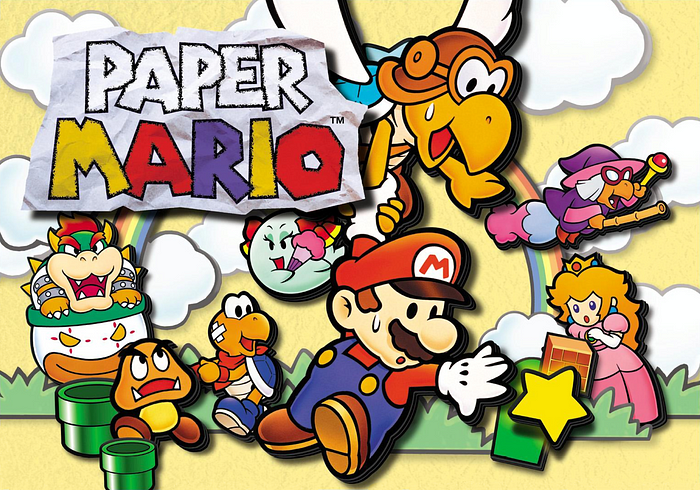Paper Mario Review

Reviews: Paper Mario: TTYD | Super Paper Mario | Paper Mario: SS | Paper Mario: CS | Paper Mario: OK
After the announcement of Paper Mario: The Origami King set to release in July, I felt immediately obligated to replay the franchise from the beginning, much like what I did with the Luigi’s Mansion trilogy. I pondered playing Super Mario RPG first but saw it more as a spiritual predecessor and hopped on Paper Mario for the N64 (aka virtual console on the Wii U).
If you know anything at all about my taste in games, it is that I’m strongly anti-narrative when it comes to most video games. Yet, contrary to my usual attitude, I undoubtedly adore role-playing games and actually consider them to be one of my favorite (probably my favorite) genres. I have always tried to find a sensible explanation for this but have never narrowed it down to anything concrete.
Perhaps my great adoration for RPGs exists because in contrast to games with their “realistic” stories, RPGs are mostly fantasy-based and contain grandiose, unrealistic storylines. Or maybe it’s the fact that you can play at your own pace rather than slogging through some gratuitous, cinematic cutscene. I’m still rather unsure as to why I’m so infatuated with the genre, but it is this very inexplicable infatuation (mixed with Nintendo’s unending charm, of course) that causes me to consider the Paper Mario games (at least the first three) to be some of my personally favorite video games.
Most of the credit belongs to the developers at Intelligent Systems for their ingenious design choices that separate the Paper Mario franchise from the traditional RPG. Of course, since the game stars Mario, it is less mature than other RPGs, but that doesn’t make it any less fun. The first of these clever choices is the turn-based battle system, both the insides and outsides of it.
As the player, you don’t just pick a move and pick an enemy to attack. You actually have to participate in the battle itself, mainly through action commands. Action commands are buttons you have to press at pinpoint moments in order to make your attack more powerful. They make battles so much more intense and player-reliant.
Throughout Mario’s eight-chapter journey, he encounters and acquires partners. All of these partners have an array of attacks that can be strategically utilized on specific enemies and their weaknesses. Partners can be upgraded to make the array even larger. They also have external abilities to primarily help Mario solve puzzles and beat obstacles outside of battle.
My only gripe with partners is their lack of agency. Another action command one can perform as Mario is “dodge,” which can lessen the power of an enemy attack if pressed at the right time. Partners lack this kind of agency in battle, causing them to be helpless at times.
Another design choice that adds loads more of strategy and flair to Paper Mario is the badge system. A limited amount of badges can be equipped (through BP — badge points) to make Mario more powerful, make his move palette more diverse, or give him a variety of many other special abilities.
For example: the “Quick Change” badge. Mario can only have one partner help fight during battle, but they can be swapped out for another partner. This would usually take up a turn, but with the Quick Change badge, equipped for 4 BP (you only start out with 3 BP), Mario can switch out the current partner with another, but the swap-out doesn’t take up the turn and allows the new partner to attack. I chose this badge because it is by far the most useful in the game, and it shows the range of power and strategy badges offer.
Outside of battle, Mario is faced with dungeons and enemy-laden paths. The enemy frequency is somehow perfect, and allows the player to level up at a smooth pace. The required battles are also frequent enough to sustain Mario at a balanced level. The dungeons don’t reach the complexity anywhere near, say, a Legend of Zelda dungeon, but are nonetheless still quaintly fun to trek through.
There are plenty of minor concepts I didn’t touch upon within this review (star power, items, special abilities specific to Mario), but that goes to show how complex and diverse Paper Mario really is. I cannot see the game being very many people’s cup of tea, for it does have some flaws (vague and uninformative, sometimes tedious story progression, with the Peach sections being nothing spectacular) but Paper Mario caters to me personally on a lot of levels: it has a shining personality, a complex amount of strategy, and perfectly paced, unprecedented gameplay.
8/10
